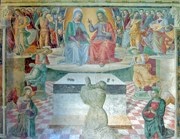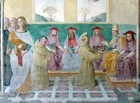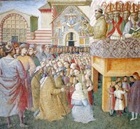Christ granting the Portiuncula Indulgence (1516)
by Tiberio d’ Assisi, Cappella delle Rose, Santa Maria degli Angeli
(The other frescoes below are also from this cycle)
According to tradition, St Francis visited Pope Honorius III at Perugia in the summer of 1216 and secured the papal confirmation of a plenary indulgence granted to him by Christ, which would be given to be given to all of those visiting the Cappella della Portiuncula after they had confessed and truly repented their sins. Honorius III conceded that this indulgence would be available in perpetuity, but only to those visiting during the 24 hours from Vespers on August 1st.
Plenary Indulgences
Indulgences reduce the period that those receiving them spend in Purgatory.
Plenary indulgences go further, providing complete temporal remission. They were first granted in 1095 to crusaders: any that died during the First Crusade, having first confessed and repented their sins, entered Heaven without spending any time in Purgatory.
The Fourth Lateran Council (1215) warned against indiscriminate and excessive indulgences. It decreed that new indulgences should generally offer maximum remission of 40 days in Purgatory, and that they should last for no more than a year. These so-called partial indulgences became quite common in the 13th century, when they were often granted, for example, to those contributing to the building of new churches.
However, plenary indulgences granted outside a crusading context remained exceptional: Pope Boniface VIII's grant of such indulgences to those visiting the basilicas of St Peter and St Paul during the Jubilee year of 1300 was considered by contemporaries as a momentous development.
The granting in 1216 of a perpetual plenary indulgence to the tiny Portiuncula was thus clearly an exceptional event. This fact, together with the silence of the early biographers, has led some historians to doubt the authenticity of the traditional account.
None of the early biographers of St Francis mentioned the granting of the Portiuncula Indulgence. It does not, for example, appear in the definitive "Legenda Maior" that St Bonaventure, the Franciscan Minister General, published in 1263. However, the oral tradition emerged in the late 1260s, and this seems to have created an increase in the flow of pilgrims to the Portiuncula, and must have promoted the cult of St Francis. This religious enthusiasm provoked opposition and criticism, based on the insecure basis for this unprecedented indulgence.
Brother Jerome of Ascoli (St Bonaventure's successor as Minister General and the future Pope Nicholas IV) therefore instituted a formal enquiry in 1276. He secured a number of notarised testimonies, the most important of which were as follows:
-
✴Brother Benedict of Arezzo and Brother Ranierio of Mariano swore that
Brother Masseo of Marignano had told them that he had accompanied St Francis to Perugia and witnessed the granting of the Indulgence. [Brother Masseo was still alive in 1276 (he died at Assisi in 1280), and it seems odd that he did not testify directly.] They also asserted that Honorius III had “ made it plain that it was not the custom of the Apostolic See to grant such an indulgence”.
-
✴Brother Peter Zalfani, the Provincial Minister, swore that he had attended the consecration of the Portiuncula and that St Francis had proclaimed the granting of the Indulgence to an audience that included seven bishops. (Later accounts specified these as the bishops of Assisi, Foligno, Gubbio, Nocera, Perugia, Spoleto and Todi).
-
✴James Coppoli of Perugia, an important benefactor of the Franciscans, swore that Brother Leo had assured him that the Indulgence had indeed been granted. According to this account, the cardinals were appalled at the scope of the indulgence, and prevailed upon Honorius III to restrict it to a single day each year.
The later tradition that Christ had appeared to St Francis and granted the Indulgence, which was confirmed by Honorius III, probably arose from an elaborate account written by Brother Michele di Bernardino in ca. 1284. He had been a young friar at the Portiuncula at the time that the Indulgence had been granted, and claimed that he had learned of the events from a conversation that took place soon after, outside St Francis’ cell. This conversation had involved most of the most important of the early followers of St Francis: Brothers Peter Catanii, Bernard of Quintavalle, Leo, Masseo of Marignano, Angelo, Philip and William of England. (Note that Brother Michele places the events in January, but Pope Honorius was in Perugia only in July and August of 1216 for the conclave in which he was elected to the papacy).
Divine Approbation for the Portiuncula Indulgence
Account of Michele di Bernardino (ca. 1284)
St Francis suffered some form of temptation while praying in the snow outside the Portiuncula. When he fought against it by leaping into a bed of brambles, a light appeared and roses bloomed where his blood had fallen.
A host of angels then appeared and urged him to rush to the Portiuncula, where Christ and the Virgin awaited him. He picked twelve red and twelve white roses from the miraculous crop and went to the church. There he found himself dressed in white before Christ, who asked him what favour he desired.
St Francis was too humble to address Christ directly, but he asked the Virgin to request the Indulgence on his behalf. Christ assented and named the day on which it could be obtained each year. He also told St Francis to seek papal ratification, taking the unseasonal roses with him as proof of Divine approbation.
Michel concludes by saying that “all these things were heard” by Brothers Peter Catanii, Rufinus, Bernard of Quintavalle and Masseo of Marignano, who had been in their cells at the Portiuncula at the time.
The Portiuncula itself only began to appear in papal documents in the reign of Nicholas IV, who exempted it from ecclesiastical interdict and granted it other privileges in a bull issued only 3 months after his election in 1288. In two other bulls issued on the same day (“Reducentes ad sedulae” and “Ecclesiam quae totius”), he decreed that funds collected at both San Francesco and Santa Maria degli Angeli should first be devoted to the conservation and decoration of the former. Any funds left over were to be used to support the friars living at the respective convents. It is clear from this that the Portiuncula was attracting significant revenues from pilgrims and other donors: but the Portiuncula Indulgence is not mentioned, let alone confirmed.
Other important compilations of material relating to the Indulgence were compiled in the 14th century:
-
✴Bishop Teobaldo Pontano wrote the definitive account of the granting of the Indulgence in 1310, in an attempt to refute the arguments of “the ignorant the jealous and contentious who try to destroy, suppress and condemn it”. It is in this document that the first evidence of direct papal approval of the Indulgence is given: Bishop Pontano asserts that Pope Boniface VIII sent legates to the Portiuncula to preach the Indulgence, probably in 1298. Since Bishop Pontano had been appointed by Boniface VIII in 1296, and since he was writing only a few years after the event that he describes, it is almost certainly correct. Bishop Pontano wrote that Jesus had inspired St Francis during the night to seek the Indulgence, although he did not elaborate on this. He recorded the surprise of Pope Honorius III that St Francis required no written proof that the Indulgence had indeed been granted, along with St Francis' reported reply: "Your word is all I need. If the Indulgence is the will of God, He will make it manifest. I desire no other document: let the Blessed Virgin Mary be my charter, let Christ be my notary, let the angels be my witnesses". (See the page on the San Francesco in the 14th Century for the relevance of this to the creation of funds for the decoration of San Francesco, Assisi).
-
✴Bishop Conrad of Assisi wrote another account in 1335, in which he drew on that of Bishop Pontano and added much of the material from the account of Michele di Bernardino.
-
✴Brother Francesco di Bartoli d' Assisi published the "Tractatus de Indulgentia Santa Maria de Portiuncula" a compendium of all the extant information relating to the Indulgence, in ca. 1335. This included the the account of Michele di Bernardino but not that of Bishop Conrad, which was probably not available to him. This tract became extremely popular: it was published in Terni in 1470 (and was probably the first book on Franciscan history to be published in Italy), and it is the main vehicle by which the tradition has come down to us.
The Portiuncula Altarpiece (1393) contains the earliest surviving narrative cycle depicting the granting of the Portiuncula Indulgence.
Later History
The construction of the new church of Santa Maria degli Angeli in the 16th century gave new life to the cult of the Portiuncula Indulgence. Even before the new church was completed, some 100,000 pilgrims visited it each year, many of them on the Festa del Perdono d' Assisi.
A succession of papal confirmations (the most recent of which was given in 1967 at the Second Vatican Council) has rendered the status of the Portiuncula Indulgence beyond doubt, and the Festa del Perdono d' Assisi is still celebrated each year, particularly at Santa Maria degli Angeli.










